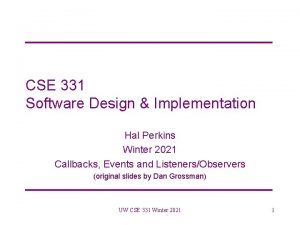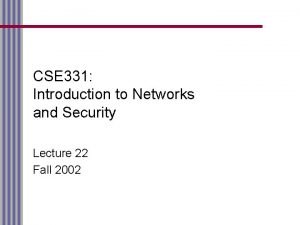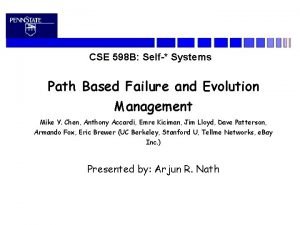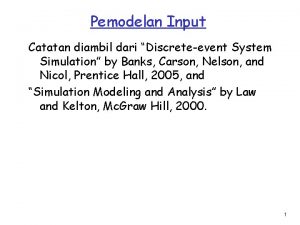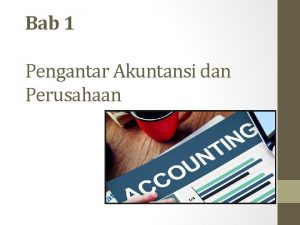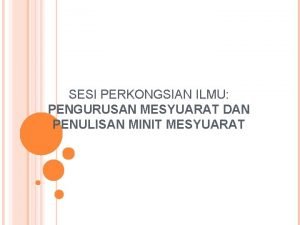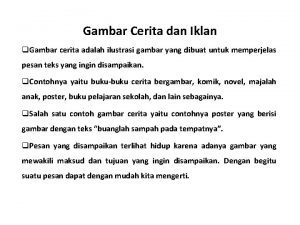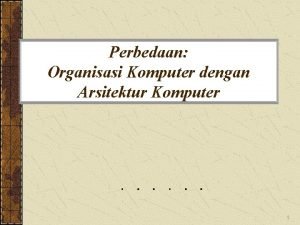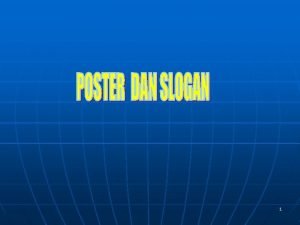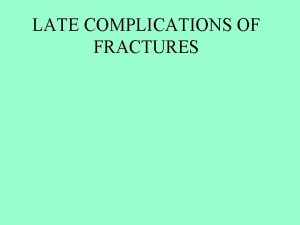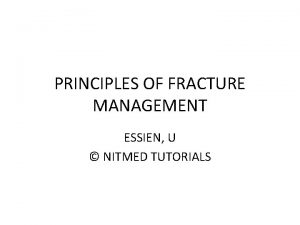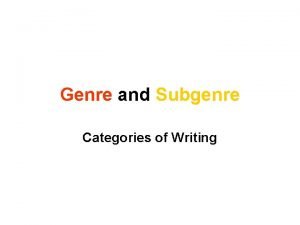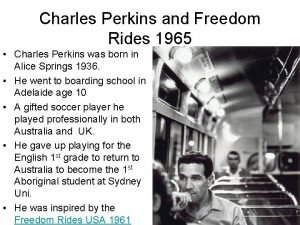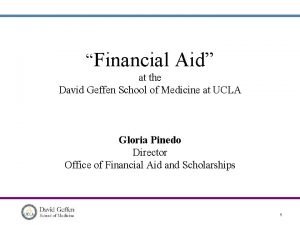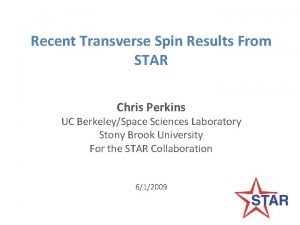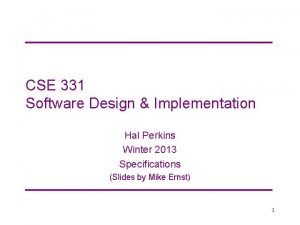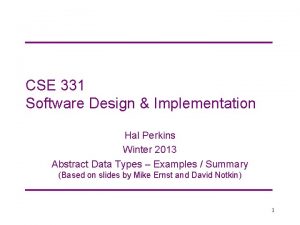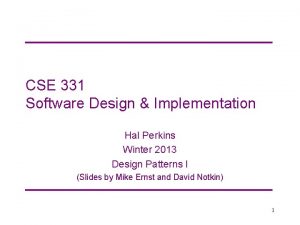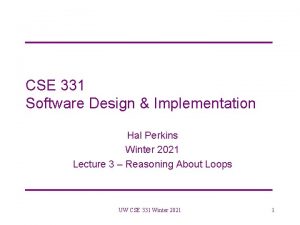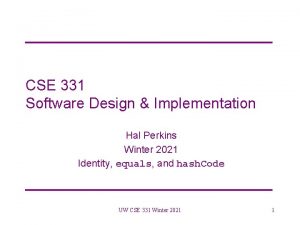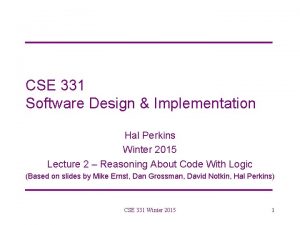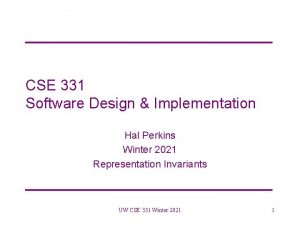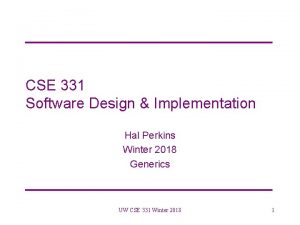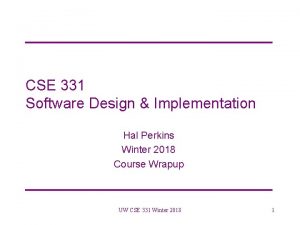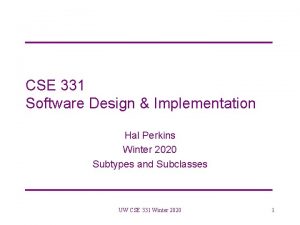CSE 331 Software Design Implementation Hal Perkins Winter





































- Slides: 37

CSE 331 Software Design & Implementation Hal Perkins Winter 2020 Lecture 2 – Reasoning About Code With Logic UW CSE 331 Winter 2020 1

Administrivia (1) • Gradescope and Ed discussion accounts created Monday and Tuesday. If you’re not set up yet, send first & last name, id # (7 digits), and @uw. edu email address to cse 331 -staff[at]cs • Office hours: initial schedule posted – Office hours: not a “study hall” (use labs for that); use to get unstuck when you really are stuck, clear up concepts, etc. – Please help us help you: organize what you want to talk about, be sure you can explain what you’ve already done and where the problems seem to be, … UW CSE 331 Winter 2020 2

Administrivia (2) • HW 1 out now, due Tuesday night, 11 pm – Reasoning about code; programming logic without loops – Today’s lecture and tomorrow’s sections • Free books!!! UW library has a site license for Safari books online, which includes access to all the CSE 331 books. See posting on Ed discussion board for details – And we’ll add readings to the calendar shortly… UW CSE 331 Winter 2020 3

Overview • Next few lectures: two presentations linked to course calendar on the web: – Lecture notes – primary source – Powerpoint slides – summary & supplement They are complementary and you should understand both of them UW CSE 331 Winter 2020 4

Reasoning about code Determine what facts are true as a program executes – Under what assumptions Examples: – If x starts positive, then y is 0 when the loop finishes – Contents of the array that arr refers to are sorted – Except at one code point, x + y == z – For all instances of Node n, n. next == null ∨ n. next. prev == n – … • Notation: In logic we often use ∧ for “and” and ∨ for “or”. Concise and convenient, but we’re not dogmatic about it UW CSE 331 Winter 2020 5

Why do this? • Essential complement to testing, which we will also study – Testing: Actual results for some actual inputs – Logical reasoning: Reason about whole classes of inputs/states at once (“If x > 0, …”) • Prove a program correct (or find bugs trying), or (even better) develop program and proof together to get a program that is correct by construction • Understand why code is correct • Stating assumptions is the essence of specification – “Callers must not pass null as an argument” – “Method will always return an unaliased object” – … UW CSE 331 Winter 2020 6

Our approach • Hoare Logic: a classic approach to logical reasoning about code – For now, consider just variables, assignments, if-statements, while-loops • So no objects or methods for now • This lecture: The idea, without loops, in 3 passes 1. High-level intuition of forward and backward reasoning 2. Precise definition of logical assertions, preconditions, etc. 3. Definition of weaker/stronger and weakest-precondition • Next lecture: Loops UW CSE 331 Winter 2020 7

Why? • Programmers rarely “use Hoare logic” in this much detail – For simple snippets of code, it’s overkill – Gets very complicated with objects and aliasing – But can be very useful to develop and reason about loops and data with subtle invariants • Examples: Homework 0, Homework 2 • Also it’s an ideal setting for the right logical foundations – How can logic “talk about” program states? – How does code execution “change what is true”? – What do “weaker” and “stronger” mean? This is all essential for specifying library-interfaces and data invariants, which does happen All the Time in The Real World® (coming lectures) UW CSE 331 Winter 2020 8

Example Forward reasoning: – Suppose we initially know (or assume) w > 0 // w > 0 x = 17; // w > 0 ∧ x == 17 y = 42; // w > 0 ∧ x == 17 ∧ y == 42 z = w + x + y; // w > 0 ∧ x == 17 ∧ y == 42 ∧ z > 59 … – Then we know various things after, including z > 59 UW CSE 331 Winter 2020 9

Example Backward reasoning: – Suppose we want z to be negative at the end // w + 17 + 42 < 0 x = 17; // w + x + 42 < 0 y = 42; // w + x + y < 0 z = w + x + y; // z < 0 – Then we know initially we need to know/assume w < -59 • Necessary and sufficient UW CSE 331 Winter 2020 10

Forward vs. Backward, Part 1 • Forward reasoning: – Determine what follows from initial assumptions – Most useful for maintaining an invariant • Backward reasoning – Determine sufficient conditions for a certain result • If result desired, the assumptions suffice for correctness • If result undesired, the assumptions suffice to trigger bug UW CSE 331 Winter 2020 11

Forward vs. Backward, Part 2 • Forward reasoning: – Simulates the code (for many “inputs” “at once”) – Often more intuitive – But introduces [many] facts irrelevant to a goal • Backward reasoning – Often more useful: Understand what each part of the code contributes toward the goal – “Thinking backwards” takes practice but gives you a powerful new way to reason about programs and to write correct code UW CSE 331 Winter 2020 12

Conditionals // initial assumptions if(…) { … // also know test evaluated to true } else { … // also know test evaluated to false } // either branch could have executed Two key ideas: 1. The precondition for each branch includes information about the result of the test-expression 2. The overall postcondition is the disjunction (“or”) of the postcondition of the branches UW CSE 331 Winter 2020 13

Example (Forward) Assume initially x >= 0 // x >= 0 z = 0; // x >= 0 ∧ z == 0 if(x != 0) { // x >= 0 ∧ z == 0 ∧ x != 0 (so x > 0) z = x; // … ∧ z > 0 } else { // x >= 0 ∧ z == 0 ∧ !(x!=0) (so x == 0) z = x + 1; // … ∧ z == 1 } // ( … ∧ z > 0) ∨ (… ∧ z == 1) (so z > 0) UW CSE 331 Winter 2020 14

Our approach • Hoare Logic, a classic approach to logical reasoning about code – [Named after its inventor, Tony Hoare] – Considering just variables, assignments, if-statements, while -loops • So no objects or methods • This lecture: The idea, without loops, in 3 passes 1. High-level intuition of forward and backward reasoning 2. Precise definition of logical assertions, preconditions, etc. 3. Definition of weaker/stronger and weakest-precondition • Next lecture: Loops UW CSE 331 Winter 2020 15

Some notation and terminology • • The “assumption” before some code is the precondition The “what holds after (given assumption)” is the postcondition • Instead of writing pre/postconditions after //, write them in {…} – This is not Java – How Hoare logic has been written “on paper” for 40 ish years { w < -59 } x = 17; { w + x < -42 } – In pre/postconditions, = is equality, not assignment • Math’s “=”, which for numbers is Java’s == { w > 0 ∧ x = 17 } y = 42; { w > 0 ∧ x = 17 ∧ y = 42 } UW CSE 331 Winter 2020 16

What an assertion means • An assertion (including pre/postconditions) is a logical formula that can refer to program state (e. g. , contents of variables) • A program state is something that “given” a variable can “tell you” its contents – Or any expression that has no side-effects – (informally, this is just the current values of all variables) • An assertion holds for a program state, if evaluating using the program state produces true – Evaluating a program variable produces its contents in the state – Can think of an assertion as representing the set of (exactly the) states for which it holds UW CSE 331 Winter 2020 17

Aside: assert statement in Java • An Java assert is a statement with a Java expression, e. g. , assert x > 0 && y < x; • Similar to our assertions – Evaluate using a program state to get true or false – Uses Java syntax • In Java, this is a run-time thing: Run the code and raise an exception if assertion is violated – Unless assertion-checking is disabled – Later course topic – but really useful to detect bugs early • This week: we are reasoning about the code, not running it on some input UW CSE 331 Winter 2020 18

A Hoare Triple • A Hoare triple is two assertions and one piece of code: {P} S {Q} – P the precondition – S the code (statement) – Q the postcondition • A Hoare triple {P} S {Q} is (by definition) valid if: – For all states for which P holds, executing S always produces a state for which Q holds – Less formally: If P is true before S, then Q must be true after – Else the Hoare triple is invalid UW CSE 331 Winter 2020 19

Examples Valid or invalid? – (Assume all variables are integers without overflow) • {x != 0} y = x*x; {y > 0} valid • {z != 1} y = z*z; {y != z} invalid • {x >= 0} y = 2*x; {y > x} invalid • {true} (if(x > 7) {y=4; } else {y=3; }) {y < 5} valid • {true} (x = y; z = x; ) {y=z} valid • {x=7 ∧ y=5} (tmp=x; x=tmp; y=x; ) {y=7 ∧ x=5} invalid UW CSE 331 Winter 2020 20

The general rules • So far: Decided if a Hoare triple was valid by using our understanding of programming constructs • Now: For each kind of construct there is a general rule – A rule for assignment statements – A rule for two statements in sequence – A rule for conditionals – [next lecture(s): ] A rule for loops – … UW CSE 331 Winter 2020 22

Basic rule: Assignment {P} x = e; {Q} • Let Q’be the same as Q except replace every x with e • Triple is valid if: For all program states, if P holds, then Q’ holds (i. e. , if P guarantees that Q’ is true, then execution of x=e; will guarantee that Q is true) • Example: {z > 34} y=z+1; {y > 1} – Q’ is {z+1 > 1} UW CSE 331 Winter 2020 23

Combining rule: Sequence {P} S 1; S 2 {Q} • Triple is valid if and only if there is an assertion R such that – {P}S 1{R} is valid, and – {R}S 2{Q} is valid • Example: {z >= 1} y=z+1; w=y*y; {w > y} (integers) – Let R be {y > 1} (this particular R picked because “it works”) – Show {z >= 1} y=z+1; {y > 1} • Use rule for assignments: z >= 1 implies z+1 > 1 – Show {y > 1} w=y*y; {w > y} • Use rule for assignments: y > 1 implies y*y > y UW CSE 331 Winter 2020 24

Combining rule: Conditional {P} if(b) S 1 else S 2 {Q} • Triple is valid if and only if there assertions Q 1, Q 2 such that – {P ∧ b}S 1{Q 1} is valid, and – {P ∧ !b}S 2{Q 2} is valid, and – Q 1 ∨ Q 2 implies Q • Example: {true} (if(x > 7) y=x; else y=20; ) {y > 5} – Let Q 1 be {y > 7} (other choices work too) – Let Q 2 be {y = 20} (other choices work too) – Use assignment rule to show {true ∧ x > 7}y=x; {y>7} – Use assignment rule to show {true ∧ x <= 7}y=20; {y=20} – Indicate y>7 ∨ y=20 implies y>5 UW CSE 331 Winter 2020 25

Our approach • Hoare Logic, a classic approach to logical reasoning about code – Considering just variables, assignments, if-statements, while -loops • So no objects or methods • This lecture: The idea, without loops, in 3 passes 1. High-level intuition of forward and backward reasoning 2. Precise definition of logical assertions, preconditions, etc. 3. Definition of weaker/stronger and weakest-precondition • Next lecture: Loops UW CSE 331 Winter 2020 26

Weaker vs. Stronger If P 1 implies P 2 (written P 1 => P 2), then: – P 1 is stronger than P 2 – P 2 is weaker than P 1 P 2 • Whenever P 1 holds, P 2 also holds • So it is more (or at least as) “difficult” to satisfy P 1 – The program states where P 1 holds are a subset of the program states where P 2 holds • So P 1 puts more constraints on program states • So it’s a stronger set of obligations/requirements UW CSE 331 Winter 2020 27

Examples • x = 17 is stronger than x > 0 • x is prime is neither stronger nor weaker than x is odd • x is prime and x > 2 is stronger than is odd and x > 2 x • … UW CSE 331 Winter 2020 28

Why this matters to us • Suppose: – {P}S{Q}, and – P is weaker than some P 1, and – Q is stronger than some Q 1 P Q Q 1 • Then: {P 1}S{Q} and {P}S{Q 1} and {P 1}S{Q 1} • Example: – P is – P 1 is – S is – Q 1 is x x y y y >= 0 > 0 = x+1 > 0 >= 0 UW CSE 331 Winter 2020 29

So… • For backward reasoning, if we want {P}S{Q}, we could instead: – Show {P 1}S{Q}, and – Show P => P 1 • Better, we could just show {P 2}S{Q} where P 2 is the weakest precondition of Q for S – Weakest means the most lenient assumptions such that Q will hold after executing S – Any precondition P such that {P}S{Q} is valid will be stronger than P 2, i. e. , P => P 2 • Amazing (? ): Without loops/methods, for any S and Q, there exists a unique weakest precondition, written wp(S, Q) – Like our general rules with backward reasoning UW CSE 331 Winter 2020 30

Weakest preconditions • wp(x = e; , Q) is Q with each x replaced by e – Example: wp(x = y*y; , x > 4) = y*y > 4, i. e. , |y| > 2 • wp(S 1; S 2, Q) is wp(S 1, wp(S 2, Q)) – i. e. , let R be wp(S 2, Q) and overall wp is wp(S 1, R) – Example: wp((y=x+1; z=y+1; ), z > 2) = (x + 1)+1 > 2, i. e. , x > 0 • wp(if b S 1 else S 2, Q) is this logic formula: (b ∧ wp(S 1, Q)) ∨ (!b ∧ wp(S 2, Q)) – (In any state, b will evaluate to either true or false…) – (You can sometimes then simplify the result) UW CSE 331 Winter 2020 31

Simple examples • If S is x = y*y and Q is x > 4, then wp(S, Q) is y*y > 4, i. e. , |y| > 2 • If S is y = x + then wp(S, Q) … = wp(y = x + = x+1 = 13 = x = 12 1; z = y – 3; and Q is z = 10, 1; 1; , z = y – 3; , z = 10) wp(z = y – 3; , z = 10)) y-3 = 10) y = 13) UW CSE 331 Winter 2020 32

Bigger example S is if (x < 5) { x = x*x; } else { x = x+1; } Q is x >= 9 wp(S, x >= 9) = (x < 5 ∧ wp(x = x*x; , x >= 9)) ∨ (x >= 5 ∧ wp(x = x+1; , x >= 9)) = (x < 5 ∧ ∨ (x >= = (x <= -3) ∨ (x >= x*x >= 9) 5 ∧ x+1 >= 9) ∨ (x >= 3 ∧ x < 5) 8) -4 -3 -2 -1 0 1 2 3 4 5 6 7 8 9 UW CSE 331 Winter 2020 33

If-statements review Forward reasoning Backward reasoning {P} if B { (B ∧ wp(S 1, Q)) ∨ (!B ∧ wp(S 2, Q)) } if B {P ∧ B} S 1 {Q 1} else {P ∧ !B} S 2 {Q 2} {Q 1 ∨ Q 2} {wp(S 1, Q)} S 1 {Q} else {wp(S 2, Q)} S 2 {Q} UW CSE 331 Winter 2020 34

“Correct” • If wp(S, Q) is true, then executing S will always produce a state where Q holds – true holds for every program state UW CSE 331 Winter 2020 35

One more issue • With forward reasoning, there is a problem with assignment: – Changing a variable can affect other assumptions • Example: {true} w=x+y; {w = x + y; } x=4; {w = x + y ∧ x = 4} y=3; {w = x + y ∧ x = 4 ∧ y = 3} But clearly we do not know w=7! UW CSE 331 Winter 2020 36

The fix • When you assign to a variable, you need to replace all other uses of the variable in the post-condition with a different variable – So you refer to the “old contents” • But only do this if you actually use the “old contents” from that variable later in the proof – omit otherwise • Corrected example: {true} w=x+y; {w = x + y; } x=4; {w = x 1 + y ∧ x = 4} y=3; {w = x 1 + y 1 ∧ x = 4 ∧ y = 3} UW CSE 331 Winter 2020 37

Useful example: swap • Swap contents – Give a name to initial contents so we can refer to them in the post-condition – Just in the formulas: these “names” are not in the program – Use these extra variables to avoid “forgetting” “connections” {x = x_pre ∧ tmp = x; {x = x_pre ∧ x = y; {x = y ∧ y = tmp; {x = y_pre ∧ y = y_pre} y = y_pre ∧ tmp = x_pre} y = tmp ∧ tmp = x_pre} UW CSE 331 Winter 2020 38
 Uw cse 331
Uw cse 331 Cse 331
Cse 331 Frank maurer
Frank maurer Winter kommt winter kommt flocken fallen nieder
Winter kommt winter kommt flocken fallen nieder Es ist kalt es ist kalt flocken fallen nieder
Es ist kalt es ist kalt flocken fallen nieder Es ist kalt es ist kalt flocken fallen nieder
Es ist kalt es ist kalt flocken fallen nieder Cse 598 advanced software analysis and design
Cse 598 advanced software analysis and design Hal-hal yang harus diperhatikan dalam membuat puisi adalah
Hal-hal yang harus diperhatikan dalam membuat puisi adalah Tujuan layout toko
Tujuan layout toko Hal-hal yang bisa diobservasi secara audial adalah… *
Hal-hal yang bisa diobservasi secara audial adalah… * Hal hal yang perlu diperhatikan dalam menulis teks iklan
Hal hal yang perlu diperhatikan dalam menulis teks iklan Syarat penulisan surat pesanan
Syarat penulisan surat pesanan Hal-hal yang esensial dalam membuat lagu
Hal-hal yang esensial dalam membuat lagu Jelaskan tujuan keberadaan etika dalam kegiatan bertelepon
Jelaskan tujuan keberadaan etika dalam kegiatan bertelepon Perhatikan hal-hal berikut.
Perhatikan hal-hal berikut. Perhatikan hal-hal berikut.
Perhatikan hal-hal berikut. Bab 1 pengantar akuntansi dan perusahaan
Bab 1 pengantar akuntansi dan perusahaan Perkara berbangkit
Perkara berbangkit Hal-hal yang perlu diperhatikan dalam kemasan produk adalah
Hal-hal yang perlu diperhatikan dalam kemasan produk adalah Contoh gambar cerita adalah
Contoh gambar cerita adalah Tes rorschach
Tes rorschach Organisasi komputer dan arsitektur komputer
Organisasi komputer dan arsitektur komputer Pengumuman biasanya memuat hal hal yang sifatnya
Pengumuman biasanya memuat hal hal yang sifatnya Perkins formula fracture
Perkins formula fracture Late complications of fracture
Late complications of fracture Carl d. perkins act of 1984
Carl d. perkins act of 1984 Animals building homes by wendy perkins
Animals building homes by wendy perkins Lars perkins
Lars perkins 4rs of fracture management
4rs of fracture management Dogs and cats by bob brady genre
Dogs and cats by bob brady genre Bag lunch by dillard perkins
Bag lunch by dillard perkins Charles perkins and the freedom rides
Charles perkins and the freedom rides Bag lunch by dillard perkins
Bag lunch by dillard perkins Myucla bruinbill
Myucla bruinbill Perkins 4008-30tag2 technical data
Perkins 4008-30tag2 technical data Chris perkins physio
Chris perkins physio Rachel perkins clinical psychologist
Rachel perkins clinical psychologist Uvm landscape change
Uvm landscape change
